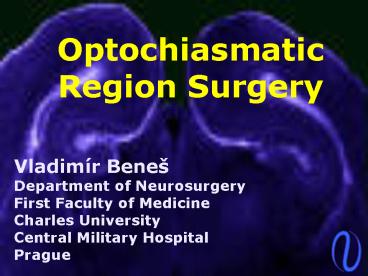Optochiasmatic Region Surgery PowerPoint PPT Presentation
1 / 56
Title: Optochiasmatic Region Surgery
1
Optochiasmatic Region Surgery
- Vladimír Bene
- Department of Neurosurgery
- First Faculty of Medicine
- Charles University
- Central Military Hospital
- Prague
2
Optochiasmatic Region
- The most frequent target in intracranial surgery
- (in general)
- The best known anatomy
- (hopefully)
- The most complex anatomy (undoubtedly)
3
(No Transcript)
4
Sellar Region Structures
- Orbit, Sphenoid Wing, Clinoid Processes
- Frontal and Temporal Lobe
- CN I., II., III., IV., V., VI.
- Optic Chiasm, Optic Tracts
- Hypothalamus
- IIIrd Ventricle, Lamina Terminalis
- Pituitary Gland, Pituitary Stalk
- ICA, ACA, MCA, AChoA, Heubner Artery
- Perforators, BA, PCom, ACom, SCA
- Cavernous Sinus, Sphenoparietal Sinus, Sylvian
Veins - Cisterns, Lillienquist Membrane
5
Lesions
- tumors
- aneurysms
- other
6
Numerous Approaches
- confusing
- overlapping
- terminology
- authorship
7
Approaches (Avenues) in General
- lateral (pterional)
- midline (bifrontal)
- basal (transsfenoidal)
- convexity (transventricular)
- posterior (far lateral)
8
Lateral
- all types of lesions
- most frequently used
- pterional and various modifications
- along the frontal aspect of the wing
- the higher the lesion the lower the approach
- first encountered structure - CN II.
9
Fronto-Lateral x Pterional
10
O-Z Approach
11
BA Aneurysm
12
P1 sin.
BA
Pcom sin.
SCA dx.
ICA
n. III dx.
n. II
a. rec. Heubneri
P1 dx.
Pcom dx.
A2 dx.
a. chor. ant.
MCA dx.
AcomA
A1 dx.
A1 sin.
13
n. III dx.
n. III sin.
BA
SCA dx.
Pcom sin.
SCA sin.
AcomA
P1 dx.
P1 sin.
14
pituitary stalk
tentorium
SCA
M1 sin.
n. IV dx.
pedunculus
15
Meningiomas
16
Ant.Clinoid Meningioma
17
Sphenoid Wing Meningioma
18
Tentorial Meningiomas
19
High Grade Glioma
20
Low Grade Glioma
21
IIIrd Nerve Schwanoma
22
IIIrd Nerve Schwanoma
23
Midline
- large midline lesions
- bifrontal and various modifications
- along the midline skull base structures
- the more posteriorly lesion the lower the
approach - first encountered structure - tumor
24
(No Transcript)
25
Bifrontal Midline Approach
26
Interorbital Approach
27
Interorbital Approach
28
Sphenoid Plane Meningioma
29
Sphenoid Plane Meningioma
30
Cribriform Plate Meningioma
31
Sellar Meningioma
32
Pterional
33
Basal
- intrasellar lesions (adenomas)
- transsfenoidal and various modification
- along the sphenoid septum
- the lower the lesion the lower the approach
- first encountered structure - pituitary gland
34
Transsphenoidal Approach
Endoscopic
35
Pituitary Adenoma
36
Pituitary Adenoma
37
Sphenoid Plane Meningioma
38
Maxillotomy
39
Hajdu-Cheney
40
Giant-Cell Bone Tumor
41
Giant-Cell Bone Tumor
42
Convexity
- lesions predominantly in the III ventricle
- behind A1 segments
- frontal parasagittal craniotomy
- transcortical x transcallosal
- via foramen Monroi
- landmarks thalamostriate vein
- corpus callosum
rd
43
Craniopharyngioma
44
(No Transcript)
45
Craniopharyngioma
46
Posterior
- Skull base lesions
- Extension to CC junction and posteriorly
- Far-lateral approach and modifications
- Along the clivus
- First encountrered structure VA
- Navigation
- Endoscopy
47
(No Transcript)
48
Chondrosarcoma
49
Chondrosarcoma
50
Optochiasmatic Region Surgery
- Choice of the Patient
- Surgery x Other Modalities
- Preop Planning
- Navigation
- Closure
- Perop and Postop Care
51
Two point technique and planning
Navigation useful in all approaches Endoscopy
assistance important
52
Optochiasmatic Region Surgery
- Sellar region lesions usually benign
- Very variable and rewarding surgery
- Dangerous surgery
53
Skull Base SurgeryDangers
- Insufficient experience
- Low number of surgeries
- Inability to brake
- Passion for trophy MRs
- Absence of common sense
54
Science and art of medicine
- Science - simple
- (cave only the best series from limited
number of authors get published) - Art - difficult
- (individual assessment of not only the
patient but that of own capabilities as well)
55
(No Transcript)
56
(No Transcript)

